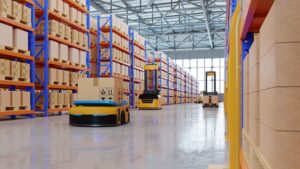Sensor systems are key enablers for smart machines
There is a continuous need to increase the functionality of machines and robots for manufacturing and inspection tasks. Underlaying driver is the need to reduce the amount of human involvement in the execution of these tasks. Examples of such machines are chip lithography machines, pick and place machines, but also Automated Guided Vehicles executing a variety of tasks in indoor and outdoor applications.
In semicon industry, the mentioned functionality increase was always about more accuracy and speed. That will continue, but next to that, machines and robots also need to be able to prepare or even take decisions on their own to reduce the amount of human involvement. Less human involvement is needed for multiple reasons. Processes inside the machines are getting so complex that humans need assistance. Chip design, or the configuration of a semicon machine for optimal performance is not possible without sensors and (machine learning based) data processing. In many industries also the scarcity of human resources brings the need for automation, like harvesting, inspection, sorting and packing tasks in agriculture.
Enable machines and robots to become smarter
In order to enable machines and robots to become smarter, one needs sensors or existing data sources in machines to feed a decision making unit.
At Nobleo we specify, design and realize such sensor systems for precision machines and Autonomous Guided Vehicles (AGV’s). Imagine an AGV that needs localization and navigation functionality in either an indoor or outdoor application. Depending on the requirements of the particular application, at Nobleo we use different types and combinations of sensors like 2D and 3D cameras, LIDAR and Time-of-Flight sensors. For outdoor localization and navigation also GPS is used, and for indoor we are familiar with the application of the Triton position sensor of Accerion.
Enhance the robustness of sensor systems
In order to enhance the robustness of sensor systems for the various conditions it has to deal with when in use by the end user, we consider to work with (application) specific markers such as Aruco markers read with cameras. Application of this type of markers enables 6Dof position measurements. But also when using LIDAR sensors it is possible to work with markers.
On a permanent basis, we keep an eye on new sensors becoming available for commercial applications, and carry out small feasibility tests to validate the specifications from the supplier. One of the implementations often used in a multi sensor application is based on a Kalman filter. If you consider it as a black box, at the input side it receives signals from different sensors. Depending on the conditions around the sensor system, these signals are inaccurate or noisy. Imagine an outdoor sensor impacted by weather conditions such as sunlight, rain of snow. A Kalman filter is able to estimate system state parameters which are not observed or measured directly, but indirectly via combining the information from above mentioned non-perfect sensor signals. In that sense, a filter is not the best name for the technology. Better consider a Kalman filter as an algorithm that can estimate both observable and unobservable system parameters, real time and with high accuracy.

Please reach out to us if you are interested in:
- Sensor technology scouting and benchmarking
- Sensor fusion
- Design of custom sensor solutions (either custom made or with off-the-shelve components)
- A technology provider in the field of machine learning for sensing systems
- Localization and navigation for AGV’s
- Agri and food inspection solutions deep learning / algorithm development